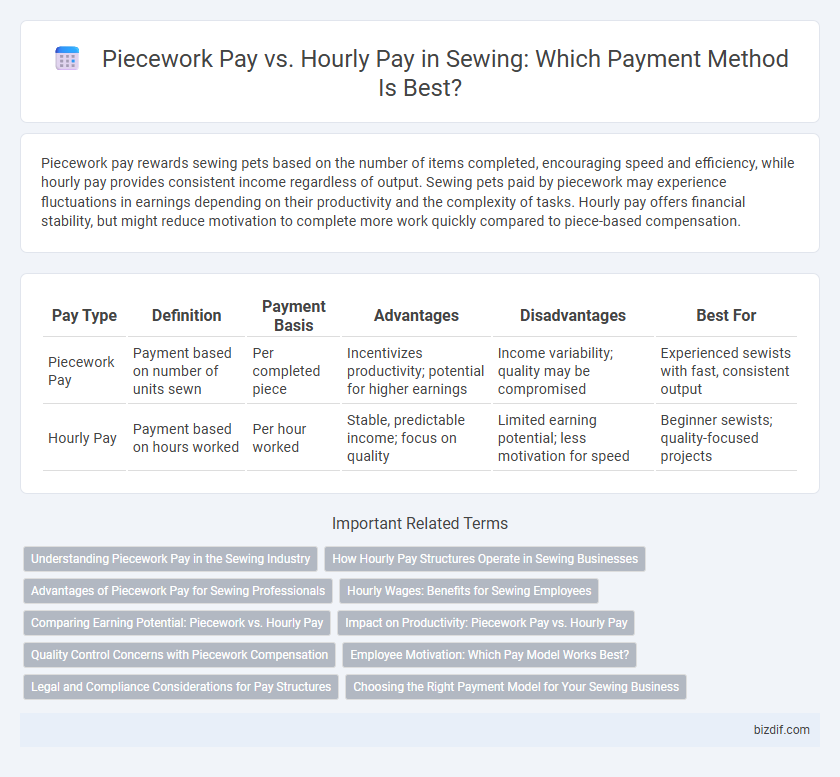Piecework pay rewards sewing pets based on the number of items completed, encouraging speed and efficiency, while hourly pay provides consistent income regardless of output. Sewing pets paid by piecework may experience fluctuations in earnings depending on their productivity and the complexity of tasks. Hourly pay offers financial stability, but might reduce motivation to complete more work quickly compared to piece-based compensation.
Table of Comparison
| Pay Type | Definition | Payment Basis | Advantages | Disadvantages | Best For |
|---|---|---|---|---|---|
| Piecework Pay | Payment based on number of units sewn | Per completed piece | Incentivizes productivity; potential for higher earnings | Income variability; quality may be compromised | Experienced sewists with fast, consistent output |
| Hourly Pay | Payment based on hours worked | Per hour worked | Stable, predictable income; focus on quality | Limited earning potential; less motivation for speed | Beginner sewists; quality-focused projects |
Understanding Piecework Pay in the Sewing Industry
Piecework pay in the sewing industry compensates workers based on the number of garments or components they complete, encouraging higher productivity and skill efficiency. This payment model benefits experienced sewists who can maintain speed and quality, often resulting in higher earnings compared to hourly wages. Understanding piecework pay requires analyzing production targets, garment complexity, and factory standards to ensure fair compensation and motivation for sewing professionals.
How Hourly Pay Structures Operate in Sewing Businesses
Hourly pay structures in sewing businesses compensate workers based on the actual time spent on tasks, ensuring consistent income regardless of production speed or output volume. This system typically includes a fixed hourly rate, sometimes with overtime pay, promoting job security and steady cash flow for employees in garment factories or tailoring shops. Employers benefit by maintaining predictable labor costs and facilitating workforce scheduling aligned with production demands.
Advantages of Piecework Pay for Sewing Professionals
Piecework pay allows sewing professionals to directly correlate their earnings with productivity, motivating higher output and efficiency. This payment method offers flexibility, enabling workers to manage their own pace and potentially earn more during peak demand periods. By incentivizing quality and speed, piecework pay encourages skill development and operational excellence in sewing projects.
Hourly Wages: Benefits for Sewing Employees
Hourly wages for sewing employees provide stable income regardless of output, ensuring financial security during slower production periods. This pay structure encourages consistent quality and attention to detail, as compensation is not solely tied to quantity. Employers benefit from increased productivity and lower turnover rates due to employees' predictable earnings and job satisfaction.
Comparing Earning Potential: Piecework vs. Hourly Pay
Piecework pay offers sewing professionals the potential to earn more by completing a higher volume of garments, as income directly correlates with productivity and efficiency. Hourly pay provides consistent, stable income regardless of output, benefiting workers in environments with variable workflow or complex tasks requiring more time per piece. Evaluating earning potential involves balancing speed, skill level, and job complexity to determine whether piece-rate incentives or fixed hourly wages maximize overall compensation in sewing roles.
Impact on Productivity: Piecework Pay vs. Hourly Pay
Piecework pay often drives higher productivity in sewing by directly linking compensation to output, motivating workers to complete more units efficiently. Hourly pay guarantees consistent income but may reduce urgency, potentially leading to slower work paces and less overall output. Choosing between piecework and hourly pay structures depends on balancing quality control with productivity goals in sewing operations.
Quality Control Concerns with Piecework Compensation
Piecework pay in sewing can compromise quality control as workers may prioritize speed over precision to maximize earnings, leading to inconsistent stitch quality and increased defects. The incentive structure often discourages meticulous inspection and correction of errors, thereby elevating the risk of substandard garments reaching customers. Employers may face higher costs from rework, returns, and damaged brand reputation due to poor quality standards under piecework compensation models.
Employee Motivation: Which Pay Model Works Best?
Piecework pay in sewing often boosts employee motivation by directly linking earnings to productivity, encouraging higher output and efficiency. Hourly pay provides financial stability, reducing stress over fluctuating income but may not incentivize faster or higher-quality work. The best model depends on the workforce's priorities: piecework suits goal-driven employees, while hourly pay appeals to those valuing consistent wages.
Legal and Compliance Considerations for Pay Structures
Legal and compliance considerations for pay structures in sewing emphasize adherence to minimum wage laws and accurate record-keeping for both piecework pay and hourly pay systems. Employers must ensure piece rates meet or exceed minimum wage thresholds when averaged over hours worked, complying with the Fair Labor Standards Act (FLSA) and related labor regulations. Proper classification of workers and transparent payment documentation reduce risks of wage disputes and regulatory penalties.
Choosing the Right Payment Model for Your Sewing Business
Choosing between piecework pay and hourly pay depends on your sewing business's production goals and quality standards. Piecework pay incentivizes faster output and can reduce labor costs, but may compromise stitch precision and overall craftsmanship if not carefully managed. Hourly pay ensures consistent quality by allowing workers to focus on detail, making it ideal for custom, high-end sewing projects requiring meticulous attention.
Piecework Pay vs Hourly Pay Infographic

 bizdif.com
bizdif.com